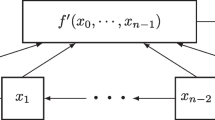Abstract
Non-linear feedback shift registers (NLFSRs) are a generalization of linear feedback shift registers in which a current state is a non-linear function of the previous state. The interest in NLFSRs is motivated by their ability to generate pseudo-random sequences which are typically hard to break with existing cryptanalytic methods. However, it is still not known how to construct large \(n\)-stage NLFSRs which generate full cycles of \(2^n\) possible states. This paper presents a method for generating full cycles by a composition of NLFSRs. First, we show that an \(n*k\)-stage register with period \(O(2^{2n})\) can be constructed from \(k\) NLFSRs with \(n\)-stages by adding to their feedback functions a logic block of size \(O(nk)\), for \(k > 1\). This logic block implements Boolean functions representing pairs of states whose successors have to be exchanged in order to join cycles. Then, we show how to join all cycles into one by using one more logic block of size \(O(nk)\).







Similar content being viewed by others
Notes
Note that the period of a shift register is traditionally defined as the length of the longest cyclic output sequence it produces [18]. For shift registers, both definitions are equivalent. However, for general registers, in which each stage can be updated by its own function, the length of the longest state cycle can be a multiple of the length of the longest cyclic output sequence. For example, the 2-stage register with the state cycle \(((00), (11), (01), (10))\) of length 4 generates the cyclic output sequence \((0,1)\) of length 2.
A 2-input gate implements a binary Boolean operation of type \(\{0,1\}^2 \rightarrow \{0,1\}\).
References
Annexstein F.S.: Generating de Bruijn sequences: an efficient implementation. IEEE Trans. Comput. 46, 198–200 (1997).
Brayton R.K., McMullen C., Hatchel G., Sangiovanni-Vincentelli A.: Logic Minimization Algorithms for VLSI Synthesis. Kluwer, Norwell (1984).
Chang T., Park B., Kim Y.H., Song I.: An efficient implementation of the D-homomorphism for generation of de Bruijn sequences. IEEE Trans. Inf. Theory 45, 1280–1283 (1999).
Cusick T.W., Stǎnicǎ P.: Cryptographic Boolean Functions and Applications. Academic Press, San Diego (2009).
David R.: Random Testing of Digital Circuits. Marcel Dekker, New York (1998).
de Bruijn N.G.: A combinatorial problem. Ned. Akad. Wet. 49, 758–746 (1946).
Dubrova E.: A list of maximum-period NLFSRs. Cryptology ePrint Archive, Report 2012/166. http://eprint.iacr.org/2012/166 (2012).
Dubrova E.: A scalable method for constructing Galois NLFSRs with period \(2^n-1\) using cross-join pairs. IEEE Trans. Inf. Theory 1(59), 703–709 (2013).
Dubrova E., Teslenko M.: Compositional properties of random Boolean networks. Phys. Rev. E 71, 056116 (2005).
Dubrova E., Teslenko M., Tenhunen H.: On analysis and synthesis of \((n, k)\)-non-linear feedback shift registers. In: Design and Test in Europe, pp. 133–137 (2008).
Etzion T., Lempel A.: Algorithms for the generation of full-length shift register sequences. IEEE Trans. Inf. Theory 3, 480–484 (1984).
Fredricksen H.M.: Disjoint cycles from de Bruijn graph. Technical Report 225, USCEE (1968).
Fredricksen H.: A class of nonlinear de Bruijn cycles. J. Comb. Theory 19(A), 192–199 (1975).
Fredricksen H.: A survey of full length nonlinear shift register cycle algorithms. SIAM Rev. 24(2), 195–221 (1982).
Gammel B., Göttfert R., Kniffler O.: Achterbahn-128/80: Design and analysis. In: SASC’2007: Workshop Record of The State of the Art of Stream Ciphers, pp. 152–165 (2007).
Gammel B.M., Göttfert R., Kniffler O.: An NLFSR-based stream cipher. In: Proceedings of IEEE International Symposium on Circuits and Systems (2006).
Gittins B., Landman H.A., O’Neil S., Kelson R.: A presentation on VEST hardware performance, chip area measurements, power consumption estimates and benchmarking in relation to the AES, SHA-256 and SHA-512. Cryptology ePrint Archive, Report 2005/415. http://eprint.iacr.org/ (2005).
Golomb S.: Shift Register Sequences. Aegean Park Press, Laguna Hills (1982).
Helleseth T., Kløve T.: The number of cross-join pairs in maximum length linear sequences. IEEE Trans. Inf. Theory 31, 1731–1733 (1991).
Jansen C.J.A.: Investigations on nonlinear streamcipher systems: construction and evaluation methods. Ph.D. Thesis, Technical University of Delft (1989).
Massey J.L.: Shift-register synthesis and BCH decoding. IEEE Trans. Inf. Theory 15, 122–127 (1969).
Schneier B.: Applied Cryptography : Protocols, Algorithms, and Source Code in C, 2nd ed. Wiley, New York (1995).
Zeng K., Yang C., Wei D., Rao T.R.N.: Pseudo-random bit generators in stream-cipher cryptography. Computer 24(2), 8–17 (1991).
Acknowledgments
The author is indebted to the anonymous reviewers for their valuable comments over the manuscript. This work was supported in part the research Grant No 621-2010-4388 from the Swedish Research Council and in part by the research Grant No SM12-0005 from the Swedish Foundation for Strategic Research.
Author information
Authors and Affiliations
Corresponding author
Additional information
This is one of several papers published in Designs, Codes and Cryptography comprising the “Special Issue on Coding and Cryptography”.
Rights and permissions
About this article
Cite this article
Dubrova, E. Generation of full cycles by a composition of NLFSRs. Des. Codes Cryptogr. 73, 469–486 (2014). https://doi.org/10.1007/s10623-014-9947-3
Received:
Revised:
Accepted:
Published:
Issue Date:
DOI: https://doi.org/10.1007/s10623-014-9947-3




